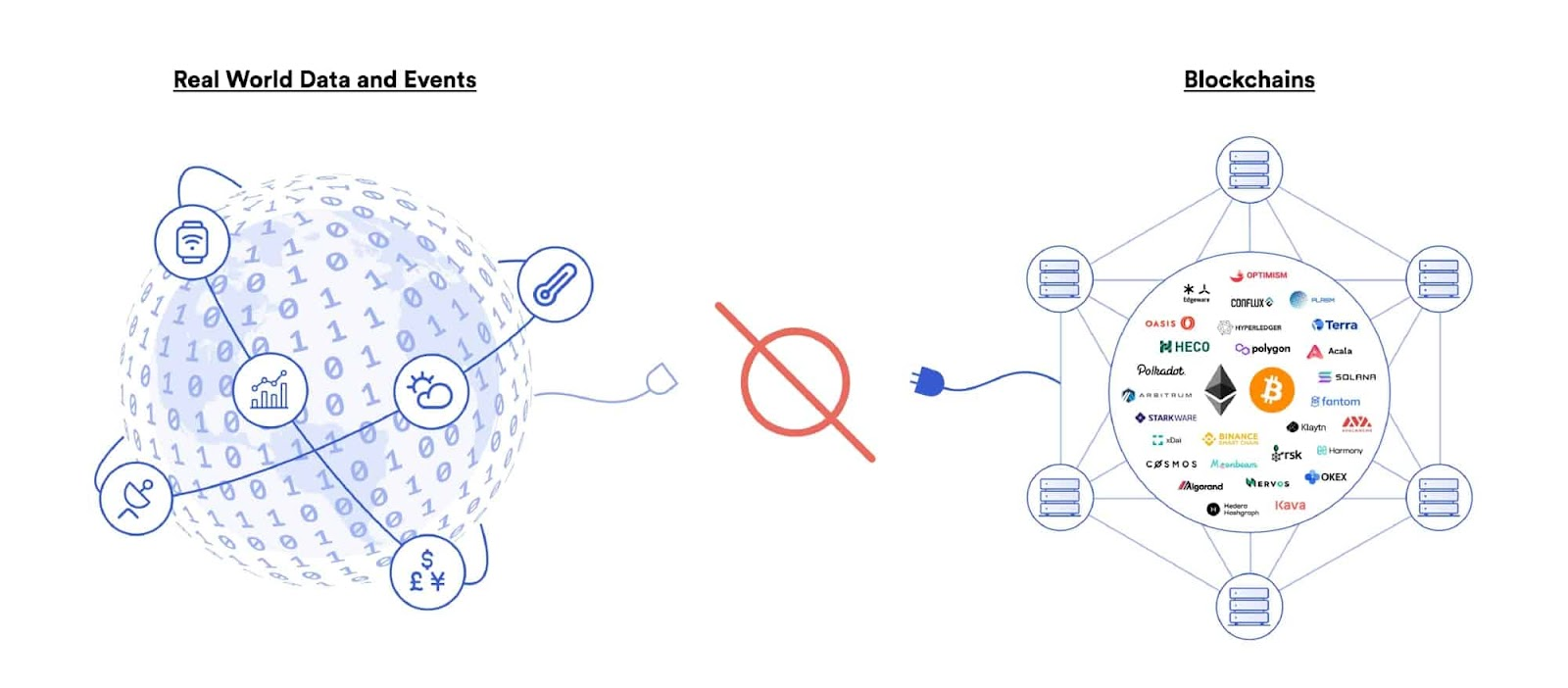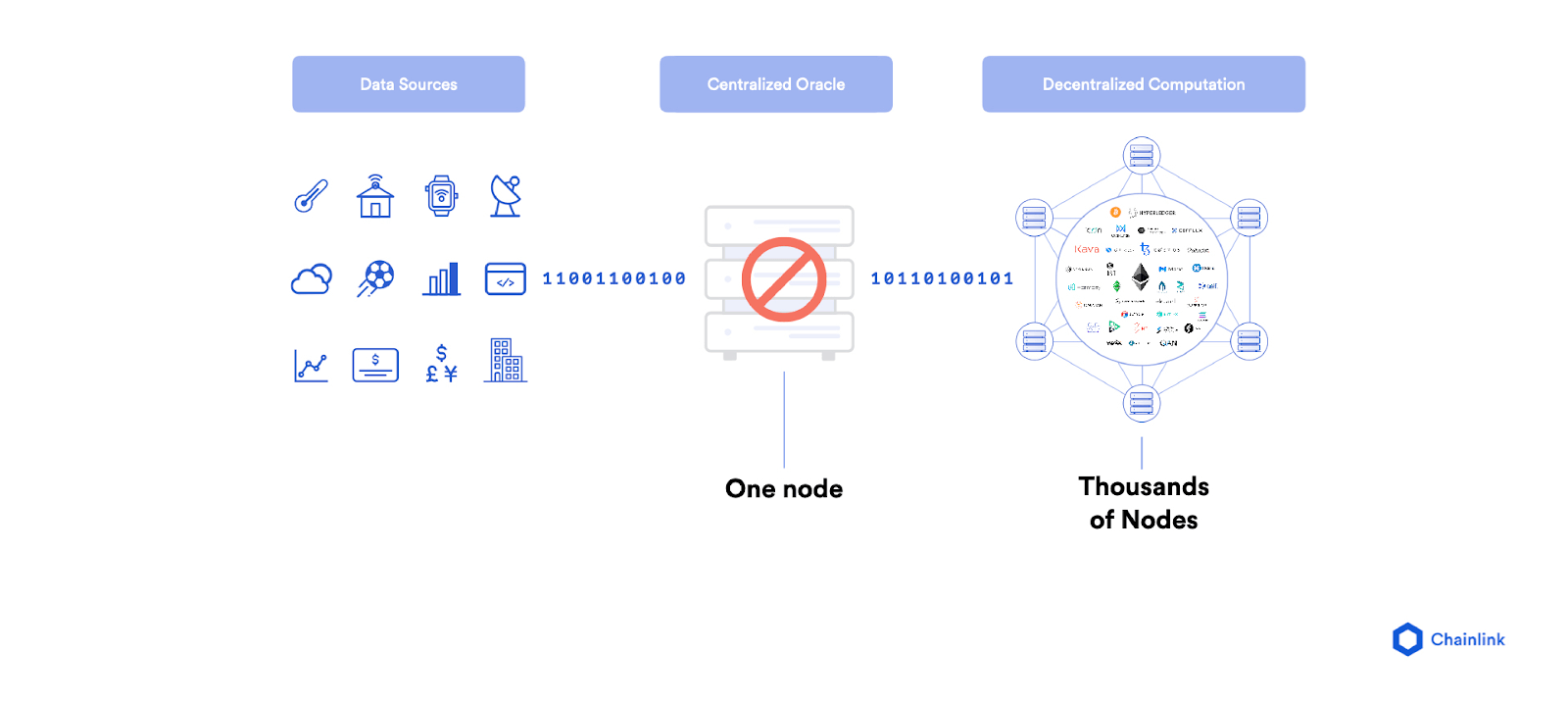# Oracles Concepts Blockchains are designed to be self-contained and deterministic systems. Deterministic means that given the same inputs, the system will always produce the same outputs. This property is crucial for security and consensus, as all blockchain nodes must agree on the state of the data for every transaction. However, due to their isolated nature, blockchains cannot directly access external (off-chain) data. While this design enhances security and data permanence, it also introduces significant trade-offs: Blockchains process transactions with higher latency than traditional computing systems due to their need for global consensus. Smart contracts have limited functionality because they cannot independently fetch real-world data (e.g., financial market prices, weather conditions, IoT sensor readings). This fundamental limitation is known as the Oracle Problem. Blockchain applications struggle to achieve full real-world applicability without a reliable way to connect with external data sources.  ## What is a Blockchain Oracle? A blockchain oracle is an infrastructure component that enables secure data exchange between blockchains and external systems. Decentralized oracles provide a trust-minimizing mechanism for bringing off-chain data onto the blockchain and allow smart contracts to be executed based on real-world events or off-chain computation. By solving the Oracle Problem, oracles can expand the capabilities of smart contracts, making them more dynamic and useful across industries like decentralized finance (DeFi) and gaming. They perform several critical functions: 1. **Listening**: Detecting when a smart contract on a blockchain is requesting external data. 2. **Fetching**: Retrieving data from off-chain sources (e.g., APIs, web servers, IoT devices). 3. **Formatting**: Converting the data into a blockchain-compatible format. 4. **Securing & Validating**: Ensuring data integrity through cryptographic verification mechanisms. 5. **Computing**: Performing off-chain computations to enhance scalability, efficiency, and security. 6. **Broadcasting**: Sending the verified data back to the blockchain. Since all nodes need to agree on the data, it is referred to as “broadcasting.” 7. **Delivery**: Delivering computation results to external systems as needed or from external systems back into smart contracts. ## Types of Blockchain Oracles 1. **Inbound Oracles**: These oracles bring external data to the blockchain. For example, they deliver information such as weather conditions, sports scores, or stock prices into a smart contract. 2. **Outbound Oracles**: These oracles send data from the blockchain to external systems. They enable smart contracts to communicate and interact with off-chain systems. 3. **Consensus Oracles**: These oracles aggregate data from multiple sources and provide a single source of truth to the smart contract. This is done to improve the reliability and accuracy of the data. 4. **Cross-Chain Oracles**: These oracles facilitate communication and data exchange between different blockchain networks (each of which is like an isolated “island”). Cross-chain oracles are essential for interoperability between different blockchains. ## Centralized vs. Decentralized Oracles ### Centralized Oracles - Operate through a single entity or node. - Risks: Single point of failure, vulnerability to attacks, and data manipulation. - If that central oracle node is compromised or stops, the blockchain can no longer access reliable external data. ### Decentralized Oracles - Use multiple independent nodes to fetch and validate data, reducing risks of manipulation and downtime. - Enhance security, transparency, and reliability by distributing trust among multiple parties to create a trust-minimized system.  ## When to Use Oracles - **Data Exchange**: Smart contracts can integrate external data sources, such as financial market feeds, insurance claim data, and gaming results. - **Automation**: smart contracts can automate processes that depend on external data, on-chain conditions, or certain time intervals. This is useful, for example, for triggering payments or executing trades based on market prices. These automation oracles can also remove the need for dependence on humans or centralized entities to trigger the operation of a smart contract when specific conditions are met. - **Cross-Chain Communication**: Smart contracts can interact with other blockchain networks, allowing for more complex and interoperable decentralized applications (dApps). - **Verifiable Randomness**: Blockchains are deterministic by design, meaning the same input will always produce the same output. This makes generating true randomness impossible on-chain. Oracles provide cryptographically verified random numbers that cannot be manipulated by miners, which is crucial for fair NFT distributions, gaming applications, and random selection processes.
Oracles Concepts
Blockchains are designed to be self-contained and deterministic systems. Deterministic means that given the same inputs, the system will always produce the same outputs. This property is crucial for security and consensus, as all blockchain nodes must agree on the state of the data for every transaction.
However, due to their isolated nature, blockchains cannot directly access external (off-chain) data. While this design enhances security and data permanence, it also introduces significant trade-offs:
Blockchains process transactions with higher latency than traditional computing systems due to their need for global consensus.
Smart contracts have limited functionality because they cannot independently fetch real-world data (e.g., financial market prices, weather conditions, IoT sensor readings).
This fundamental limitation is known as the Oracle Problem. Blockchain applications struggle to achieve full real-world applicability without a reliable way to connect with external data sources.

What is a Blockchain Oracle?
A blockchain oracle is an infrastructure component that enables secure data exchange between blockchains and external systems. Decentralized oracles provide a trust-minimizing mechanism for bringing off-chain data onto the blockchain and allow smart contracts to be executed based on real-world events or off-chain computation.
By solving the Oracle Problem, oracles can expand the capabilities of smart contracts, making them more dynamic and useful across industries like decentralized finance (DeFi) and gaming.
They perform several critical functions:
Listening: Detecting when a smart contract on a blockchain is requesting external data.
Fetching: Retrieving data from off-chain sources (e.g., APIs, web servers, IoT devices).
Formatting: Converting the data into a blockchain-compatible format.
Securing & Validating: Ensuring data integrity through cryptographic verification mechanisms.
Computing: Performing off-chain computations to enhance scalability, efficiency, and security.
Broadcasting: Sending the verified data back to the blockchain. Since all nodes need to agree on the data, it is referred to as “broadcasting.”
Delivery: Delivering computation results to external systems as needed or from external systems back into smart contracts.
Types of Blockchain Oracles
Inbound Oracles: These oracles bring external data to the blockchain. For example, they deliver information such as weather conditions, sports scores, or stock prices into a smart contract.
Outbound Oracles: These oracles send data from the blockchain to external systems. They enable smart contracts to communicate and interact with off-chain systems.
Consensus Oracles: These oracles aggregate data from multiple sources and provide a single source of truth to the smart contract. This is done to improve the reliability and accuracy of the data.
Cross-Chain Oracles: These oracles facilitate communication and data exchange between different blockchain networks (each of which is like an isolated “island”). Cross-chain oracles are essential for interoperability between different blockchains.
Centralized vs. Decentralized Oracles
Centralized Oracles
Operate through a single entity or node.
Risks: Single point of failure, vulnerability to attacks, and data manipulation.
If that central oracle node is compromised or stops, the blockchain can no longer access reliable external data.
Decentralized Oracles
Use multiple independent nodes to fetch and validate data, reducing risks of manipulation and downtime.
Enhance security, transparency, and reliability by distributing trust among multiple parties to create a trust-minimized system.

When to Use Oracles
-
Data Exchange: Smart contracts can integrate external data sources, such as financial market feeds, insurance claim data, and gaming results.
-
Automation: smart contracts can automate processes that depend on external data, on-chain conditions, or certain time intervals. This is useful, for example, for triggering payments or executing trades based on market prices. These automation oracles can also remove the need for dependence on humans or centralized entities to trigger the operation of a smart contract when specific conditions are met.
-
Cross-Chain Communication: Smart contracts can interact with other blockchain networks, allowing for more complex and interoperable decentralized applications (dApps).
-
Verifiable Randomness: Blockchains are deterministic by design, meaning the same input will always produce the same output. This makes generating true randomness impossible on-chain. Oracles provide cryptographically verified random numbers that cannot be manipulated by miners, which is crucial for fair NFT distributions, gaming applications, and random selection processes.
Oracle Concepts
A foundational introduction to Oracles Concepts - Understand the Oracle Problem and how blockchain oracles bridge the gap between blockchains and external data sources. Explore oracle functions, types, centralized vs. decentralized models, and key use cases.
Course Overview
About the course
What you'll learn
Smart contract and Solidity fundamentals
Chainlink’s decentralized oracle network (DON)
Chainlink Data Feeds
Chainlink Data Streams
Chainlink Automation
Chainlink CCIP
Chainlink Functions
Verifiable Random Function (VRF)
Chainlink Proof of Reserve
Course Description
Who is this course for?
- Smart Contract Developers
- Solutions Architects
- Blockchain Engineers
- Web3 Developers
- Security Researchers
Potential Careers
Smart Contract Engineer
$100,000 - $150,000 (avg. salary)
DeFi Developer
$75,000 - $200,000 (avg. salary)
Web3 developer
$60,000 - $150,000 (avg. salary)
Web3 Developer Relations
$85,000 - $125,000 (avg. salary)
Smart Contract Auditor
$100,000 - $200,000 (avg. salary)
Security researcher
$49,999 - $120,000 (avg. salary)
Blockchain Financial Analyst
$100,000 - $150,000 (avg. salary)
Last updated on July 25, 2025
Certification: Chainlink Fundamentals
The Chainlink Fundamentals proficiency exam covers is designed to confirm your grasp of all key concepts and learnings presented in the course material. Exam takers will have 75 minutes to complete 50 questions and must score 30/50 to pass and earn a Certificate of Completion. Because course material is continually updated, The Chainlink Fundamentals Certificate of Completions expires after 1 year. To remain current, holders must re-take the exam and pass to confirm their current knowledge.
Course Overview
About the course
What you'll learn
Smart contract and Solidity fundamentals
Chainlink’s decentralized oracle network (DON)
Chainlink Data Feeds
Chainlink Data Streams
Chainlink Automation
Chainlink CCIP
Chainlink Functions
Verifiable Random Function (VRF)
Chainlink Proof of Reserve
Course Description
Who is this course for?
- Smart Contract Developers
- Solutions Architects
- Blockchain Engineers
- Web3 Developers
- Security Researchers
Potential Careers
Smart Contract Engineer
$100,000 - $150,000 (avg. salary)
DeFi Developer
$75,000 - $200,000 (avg. salary)
Web3 developer
$60,000 - $150,000 (avg. salary)
Web3 Developer Relations
$85,000 - $125,000 (avg. salary)
Smart Contract Auditor
$100,000 - $200,000 (avg. salary)
Security researcher
$49,999 - $120,000 (avg. salary)
Blockchain Financial Analyst
$100,000 - $150,000 (avg. salary)
Last updated on July 25, 2025

